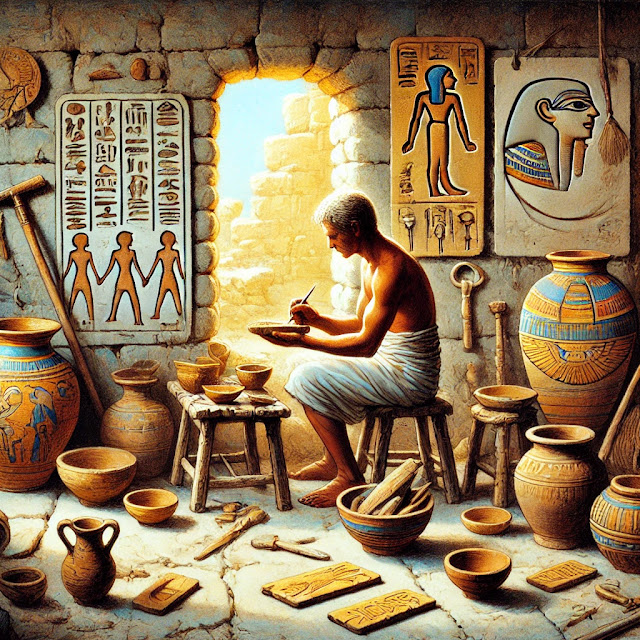The ancient Egyptians, renowned for their monumental achievements,
were also masters of sustainability and recycling. Their innovative practices
resonate with today's quest for eco-friendly solutions. Here’s how their
ancient methods offer insights into modern environmental challenges:
1. Ingenious
Recycling Practices
The
Egyptians demonstrated resourcefulness by repurposing everyday items to avoid
waste.
- Example: Broken pottery wasn’t
discarded—it was reshaped into writing tablets or grain-measuring tools.
- Example: Metal artifacts, such as tools
and jewelry, were melted down and recast into new objects.
Takeaway for Today: Modern recycling efforts can mirror
these techniques by focusing on repurposing materials for different uses.
2. Sustainable
Agriculture Along the Nile
The Nile
River played a central role in sustaining Egypt’s agricultural economy.
- Example: The annual flooding of the Nile
deposited nutrient-rich silt on farmlands, acting as a natural fertilizer.
- Example: Sophisticated irrigation
systems, including canals and reservoirs, ensured water was conserved and
utilized efficiently.
Takeaway for Today: Regenerative farming and
water-saving technologies can be inspired by these ancient methods to enhance
food security.
3. Eco-Friendly
Architecture
Egyptian
builders understood the importance of constructing homes and monuments that
harmonized with their environment.
- Example: Mud bricks, made from Nile
silt, were biodegradable, renewable, and provided excellent insulation.
- Example: Temples and palaces
incorporated natural ventilation systems to cool interiors during extreme
heat.
Takeaway for Today: Architects can adopt similar
principles by designing energy-efficient, climate-responsive buildings.
4. Circular Economy
in Daily Life
The
Egyptians practiced a circular economy long before the term existed.
- Example: Plant remains, like reeds and
papyrus, were used for making baskets, ropes, and even small boats.
- Example: Animal by-products, such as
bones, became tools, ornaments, or fertilizer.
Takeaway for Today: Zero-waste lifestyles and
closed-loop production systems can draw inspiration from these ancient
practices.
5. Respect for
Natural Resources
The
Egyptians thrived in a resource-limited environment by maximizing every
available material.
- Example: Solar energy was used for
drying crops and preserving food.
- Example: They relied on local materials,
reducing transportation needs and minimizing environmental impact.
Takeaway for Today: Adopting renewable energy sources
and prioritizing local materials can help reduce carbon footprints.
Key Lessons for the
Modern World
The
ancient Egyptians remind us that sustainability is not a new trend but a proven
way of life. By respecting resources, recycling materials, and embracing
eco-friendly innovations, we can create a more sustainable future for
generations to come.
Inspiring Quote
"Waste
is not waste until you waste it." – Unknown
This
philosophy, embodied by the ancient Egyptians, is a powerful reminder of the
value hidden in what we often discard.
Conclusion
As we
face challenges like climate change, waste pollution, and resource depletion,
looking back at ancient practices can provide us with timeless solutions. From
recycling and sustainable agriculture to eco-friendly architecture, the
Egyptians showed us that harmony with nature is achievable.
Let’s
take inspiration from history to build a greener, more sustainable future.
Keywords:
- Recycling and sustainability
- Ancient Egyptian eco practices
- Sustainable farming techniques
- Green architecture inspiration
- Zero-waste lifestyle
- Renewable energy innovations
- Historical lessons for modern
sustainability



